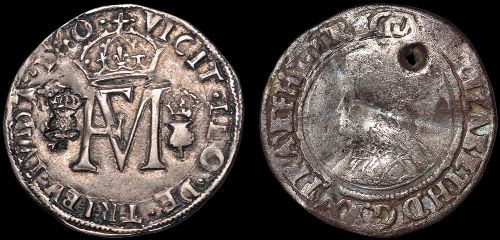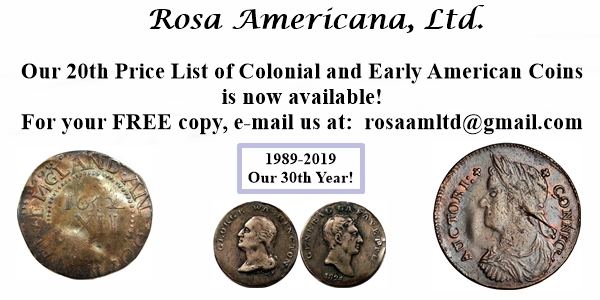
PREV ARTICLE
NEXT ARTICLE
FULL ISSUE
PREV FULL ISSUE
THE GREAT RECOINAGE OF 1696Allan Davisson published this article in a November 13, 2020 email message in advance of the Davisson's E-Auction 37 closing Wednesday, November 18th. With permission, we're republishing it here. Thanks. -Editor

Revalued Mary Stuart testoon The British section of E-Auction 37 has many notable lots–some nice hammered including an exceptional William II profile penny, further offerings from the Frank Robinson collection of British Milled, and more! Rather than take you though all the highlights, however, we are focusing on just one unassuming piece. Read on to see what makes the hole in lot 104 so special.
Base issue coinage-sharply devalued coinage that persisted after the remarkable efforts of Edward VI to reform English currency-plagued English trade. The lack of small change had still not been alleviated when in 1560 the remnants of low silver shillings left over from Edward's reign were revalued down to represent their underlying silver value. A portcullis countermark or a greyhound countermark told users what they could expect these sorry pieces to pass for. The Scots had a different problem to solve in 1578 when their coinage was worth more than the bullion it contained. The value of silver had climbed so that a thirty-shilling coin now had 36 shillings worth of silver in it. This incentive to export silver coinage for melting meant that change would quickly disappear. After all, simply melting the piece brought about a quick 20% profit. The answer was to countermark these over-rich coins with a thistle countermark so that every user would know that what had been 30 shillings would now be accepted in trade as a 36 shilling 9 pence piece. The problem in 1696 was more related to the 1560 issue-coinage with a face value that did not match the underlying silver value. In 1560 it had been debased metal. By 1696 the problem was size reduction of the currency by clipping around the edge. Shaving slivers of silver could be very profitable if someone could leave just enough of the original coin that it would still pass for full value. The problem was that the practice was wide-spread and repeated to such an extent that there was little money-particularly in and around London-that was worth what it was supposed to be worth. It was a new era in England. William III was the ruler. Sir Isaac Newton was running the Mint and there was a crisis in small change. Hammered coins were still monetized (with the exception of the Commonwealth issues) and were still in demand for daily use, even though that use was problematic because of all the clipping. Unclipped and the "unclippable" milled coins that had been minted for 30 years were hard to find for several reasons. Milled coins were minted in limited quantities because the Mint, dependent on silver coming to it, was not getting nearly enough to be able to keep up with demand. People hoarded the full value pieces, recognizing that they could be worth more regardless of the designated denomination. As the value of silver fluctuated these full-weight silver coins were exported to be melted whenever the bullion value exceeded the denominated value. To rectify all this, Newton proposed a plan to take in hammered coins at full face value, clipped or not, for reminting. This brought about the act authorizing The Great Recoinage of 1696. No clipped crowns or half crowns after February 3rd, and no clipped shillings or sixpences after February 22nd would be considered current in London or within 40 miles. After March 2nd no clipped coin could be considered as current except for government payments. This was an expensive process for the Mint. While coinage was reestablished and hammered coinage was no longer current, estimates published soon after the recoinage placed the government's loss at a million pounds because they took in clipped coins at full value. A seven-year tax on houses based on the number of windows in the house was put in place (and you can still see London houses from the era with windows bricked up to escape the tax). This procedure allowed the process to stretch recoining out over successive periods to avoid the Mint becoming overwhelmed with silver. Branch mints were set up around the country-Bristol, Chester, Exeter, Norwich, and York. By taking in silver and coining at all these locations, the new coins could be produced and distributed more quickly than if everything were sent to London. (William III halfcrowns, shillings, and sixpences from these mints all bear an initial indicating where they were struck.) At the same time, there was still a need to have circulating coins, so the government opted to mark unclipped coins and return them to circulation. The Act was passed on January 17th, 1696 and February 10th was the deadline when the only coins that would be current would be those that had been punched. The terms were explicit: "...unclipt hammered Monies should…before the tenth day of February one thousand six hundred and ninety five… call such unclipped monies to be struck through about the middle of every piece, with a solid punch that should make a hole without diminishing the Silver." "Unclipt" was defined as having "both rings." After this, any appropriately holed coin would be forfeit if it was subsequently found clipped. There is debate about who was responsible for this fast method of marking "good coin"-the Treasury/Mint, Justices of the Peace along with local authorities, or individuals who recognized that their coins would lose value after the deadline. A February 1984 Seaby Bulletin analysis by I. D. Brown notes that the only solution to getting the work done was to allow "each person to mark the good coins in his possession with a simple device such as a hammer and nail." The piece shown here came from a metal detector's accumulation of finds during guided trips to the English countryside. It is an unclipped second issue groat of Elizabeth with a hole punched near the middle that avoids the portrait. The jagged edges of the hole match exactly with images of other "punched" coins of the era. Such pieces prove to be very rare-few have survived as was first noted in articles in the Seaby Bulletin, particularly in a 1983 article by Garry Charman. Considering collector preferences and tastes, coins with such holes in them tend to be tossed into the melting pot and a piece such as this was simply lost at the time and only dug up recently when we are more aware of this little side-trip in numismatic history.
For more information on the sale, see:

Wayne Homren, Editor The Numismatic Bibliomania Society is a non-profit organization promoting numismatic literature. See our web site at coinbooks.org. To submit items for publication in The E-Sylum, write to the Editor at this address: whomren@gmail.com To subscribe go to: https://my.binhost.com/lists/listinfo/esylum All Rights Reserved. NBS Home Page Contact the NBS webmaster 
|